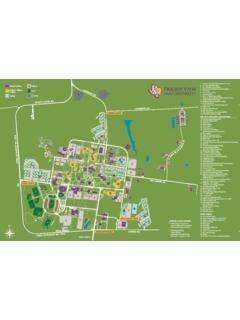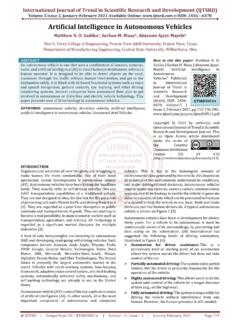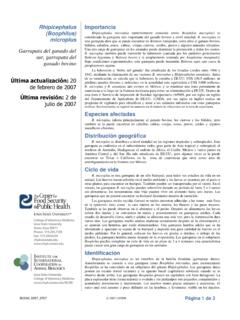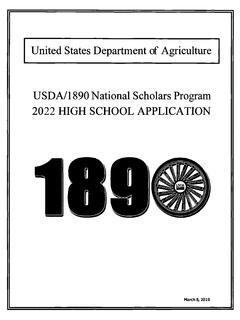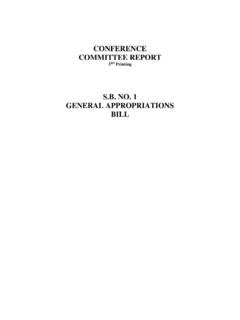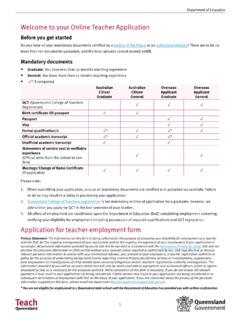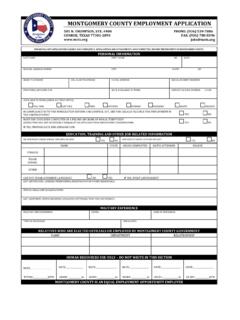Transcription of Agricultural and Food Policy Center Texas A&M University ...
1 Agricultural and Food Policy Center Texas A&M University January 2022. Economic Impact of Higher Fertilizer Prices on AFPC's Representative Crop Farms AFPC. department of Agricultural Economics Texas AgriLife Research college Station, Texas 77843-2124. Telephone: (979) 845-5913. Texas AgriLife Extension Service Fax: (979) 845-3140. Texas A&M University | . 2022 by the Agricultural and Food Policy Center Briefing Paper 22-01. Photos courtesy USDA. Agricultural and Food Policy Center department of Agricultural Economics 2124 TAMU. college Station, TX 77843-2124. Web site: Twitter: 01/06/2022__0. Economic Impact of Higher Fertilizer Prices on AFPC's Representative Crop Farms Joe L. Outlaw Henry L. Bryant J. Marc Raulston George M. Knapek Brian K. Herbst Bart L. Fischer AFPC . Agricultural and Food Policy Center The Texas A&M University System Agricultural & Food Policy Center department of Agricultural Economics Texas A&M AgriLife Research Texas A&M AgriLife Extension Service Texas A&M University Briefing Paper 22-01.
2 January 2022. college Station, Texas 77843-2124. Telephone: Fax: Web site: Twitter: Economic Impact of Higher Fertilizer Prices on AFPC's Representative Crop Farms 1. 2 Economic Impact of Higher Fertilizer Prices on AFPC's Representative Crop Farms Introduction This report analyzes the economic impacts of higher fertilizer prices on the Agricultural and Food Policy Center 's (AFPC's) 64 representative crop farms. The analysis was requested by Representative Julia Letlow from the 5th District of Louisiana. The results are presented relative to the August 2021 FAPRI Baseline analy- sis. Additional detail is presented for the Louisiana representative grain farm that is located in her Congressio- nal district. Background According to USDA, fertilizer use by producers peaked in 1981 at million Since that time, fertilizer use has experienced annual volatility with no persistent trend.
3 Of the three primary types of com- mercial fertilizer nitrogen, phosphorus, and potassium (NPK) nitrogen accounts for more than 50 percent of total use by weight. Recent fertilizer price increases across all three primary nutrients have caused signifi- cant concern among producers. For the 2022 crop, producers are experiencing sticker shock as well as prod- uct shortages (Figure 1). 1. $1,200. $1,000. $800. Dollars per Ton $600. $400. $200. $0. 6. 9. 2. 5. 8. 1. 4. 7. 0. 95. 98. 01. 4. 07. 10. 3. 16. 19. l-9. l-9. l-0. l-0. l-0. l-1. l-1. l-1. l-2. -0. -1. n- n- n- n- n- n- n- n n Ju Ju Ju Ju Ju Ju Ju Ju Ju Ja Ja Ja Ja Ja Ja Ja Ja Ja Nitrogen Potassium Phosphorous (DAP). Figure 1: Monthly Average Fertilizer Nutrient Prices, January 1995 to October 2021. Source: Compiled from DTN spot market price data for the last trading day of each month.
4 The markets include New Or- leans, Corn Belt, Southern Plains, South central , Southeast and Florida. The phosphorous price is specifically for diam- monium phosphate (DAP). Economic Impact of Higher Fertilizer Prices on AFPC's Representative Crop Farms 3. Data and Methods Model For over 30 years, AFPC has maintained a farm-level Policy simulation model (FLIPSIM) developed by Richardson and Nixon (1986) for analyzing the impact of proposed Policy changes on farms and ranch- es. AFPC currently uses a next generation simulation model Farm Economics and Solvency Projector (FarmESP) developed by Dr. Henry Bryant, that moves to the Python platform and includes all of the previ- ous generation's Policy and tax capabilities with a significant upgrade in terms of crop insurance capabilities. Data The data to simulate farming operations in FarmESP comes primarily from AFPC's database of represen- tative farms.
5 Information to describe and simulate these farms comes from panels of farmers (typically 4-6. producers per location) located in major production regions in 21 states across the United States. The farm panels are reconvened frequently to update the representative farm data. The representative farms are catego- rized by their primary source of receipts for example, feedgrain, wheat, cotton and rice. The representative farm database has been used for Policy analysis for over 30 years analyzing the impacts of proposed policies on the past seven farm bills. As noted above, this report focuses on AFPC's 64 representative crop farms (Figure 2). 2800. 10000 9500. 3000. 5500 9000. 4500. 1350. 3400. 2400 700. 4500 1500. 800 3000 2300. 6000. 1200 4000 2300 1000. 3000 8000 4200 3500. 800 2000. 5300. 4000. 4000 2500. 5000 1600. 5000 3000 2030. 2500 4000.
6 3500 2000 2000. 3240. 5000 5000 3500. 3000 6500. 3000 2500. 1600 1500 2500. 3450 2500 4500 3000. 10880 2000. 2500. 4000 2500. 10000 1800. 5500. Figure 2: Location of AFPC Representative Crop Farms by Type. 4 Economic Impact of Higher Fertilizer Prices on AFPC's Representative Crop Farms Table 1: FAPRI August 2021 Baseline Update Crop Prices, 2019-2026. Crop Prices 2019 2020 2021 2022 2023 2024 2025 2026. Corn ($/bu.) Wheat ($/bu.) Upland Cotton Lint ($/lb.) Sorghum ($/bu.) Soybeans ($/bu.) Barley ($/bu.) Oats ($/bu.) All Rice ($/cwt.) Soybean Meal ($/ton) All Hay ($/ton) Peanuts ($/ton) Source: Food and Agricultural Policy Research Institute (FAPRI) at the University of Missouri-Columbia. Table 2: FAPRI August 2021 Baseline Update Assumed Rates of Change in Input Prices and An- nual Changes in Land Values, 2020-2026. 2020 2021 2022 2023 2024 2025 2026.
7 Annual Rate of Change for Input Prices Paid Seed Prices (%) Nitrogen Fertilizer Prices (%) Potash and Phos. Fertilizer Prices (%) Herbicide Prices (%) Insecticide Prices (%) Fuel and Lube Prices (%) Machinery Prices (%) Wages (%) Supplies (%) Repairs (%) Services (%) Taxes (%) PPI Items (%) PPI Total (%) Annual Change in Consumer Price Index (%) Annual Rate of Change for Land Prices (%). Source: Food and Agricultural Policy Research Institute (FAPRI) at the University of Missouri-Columbia. Projected commodity prices, Policy variables, and input inflation rates are from the Food and Agricultural Policy Research Institute (FAPRI) August 2021 Baseline (Tables 1 and 2). Each representative farm is simulated using the FarmESP model assuming FAPRI's projected prices and annual inflation rates through 2022 for the Baseline Scenario. AFPC's representative farms are all assumed to be full-time, commercial-scale family operations.
8 As indicated in Table 1, most commodities are expected to continue to see better than average prices over the next year. Model Modifications The inflation rates for fertilizer nutrient prices obtained from FAPRI in Table 2 were evaluated and deter- mined to be quite low relative to current market conditions. Spot market data obtained from DTN was evalu- Economic Impact of Higher Fertilizer Prices on AFPC's Representative Crop Farms 5. Table 3: Fertilizer Nutrient Inflation from the FAPRI Baseline and High Fertilizer Scenario for 2022. Nutrient FAPRI August Baseline 2022 High Fertilizer Scenario 2022. Nitrogen (AA) Potash and Phosphorous ated and the cost indices for both fertilizer categories in Table 2 were adjusted for the higher prices experi- enced thus far in 2021 that are assumed for 2022. The FarmESP model assumes all fertilizer used for the 2022.
9 Crop is purchased in 2022 rather than some in the Fall of 2021 and the rest during 2022. Scenarios Analyzed The following 2 scenarios were analyzed for each of the 64 representative crop farms: Baseline Scenario. Each farm is analyzed assuming FAPRI November Baseline commodity prices and inflation rates (Tables 1 and 2). High Fertilizer Scenario. Same as the Baseline Scenario with fertilizer nutrient inflation for 2022. from Table 3. Results In the results tables that follow, the first two letters of a farm name reflect the state abbreviation followed by letters (in many cases) describing geographic location and type of farm ( , G for feedgrain, W for wheat, etc.). Some locations have both a moderate and large-sized farm, while others have only one farm size of that type in the region. The number in a farm's name indicates the total acres on the farm.
10 Appendix A provides an overview of the characteristics of AFPC's representative farms. Appendix B provides the names of producers, land grant faculty, and industry leaders who cooperated in the panel interview process to develop the repre- sentative farms. Additional information about the representative farms can be found in AFPC Working Paper 21-1 by Outlaw et al., March 2021. The breakdown of the 64 crop farms by type is as follows: Feedgrain: 25. Wheat: 11. Cotton: 13. Rice: 15. Tables 4-7 contain the simulation results for each of the representative crop farms. The primary economic variable being evaluated is ending cash at the end of 2022 under the Baseline Scenario and the High Fertil- izer Scenario labeled Alternative. As would be expected with only fertilizer costs increasing, the difference in ending cash is negative for all farms.
